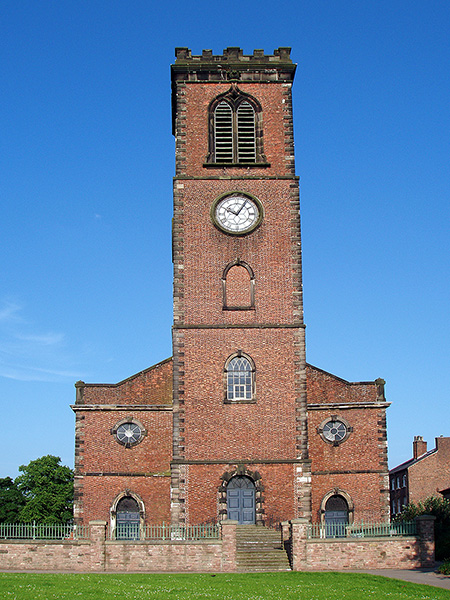 |
| Christ Church, June 2005 |
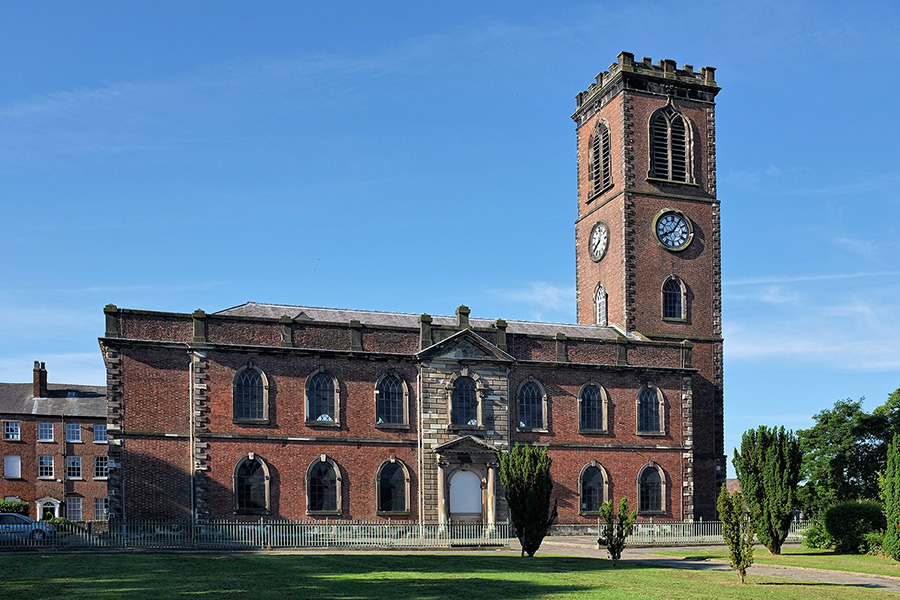 |
| Christ Church from the North early on a midsummer morning, 3 July 2015 |
 |
| Christ Church, June 2005 |
 |
| Christ Church from the North early on a midsummer morning, 3 July 2015 |
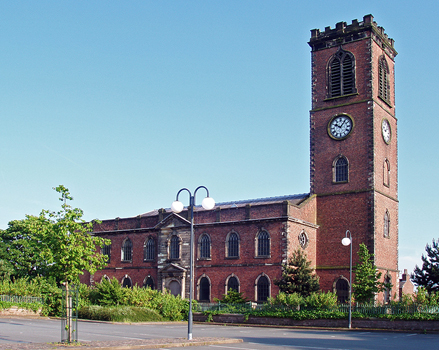 |
 |
|
| Christ Church from the North West in evening light | Christ Church from the South East. | |
 |
 |
|
| The East Window | View to the West End | |
 |
 |
|
| Monument to Charles Roe | The Font | |
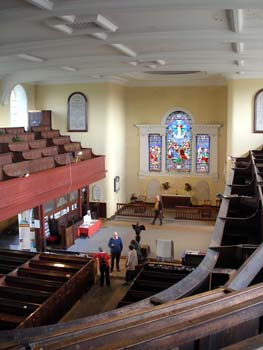 |
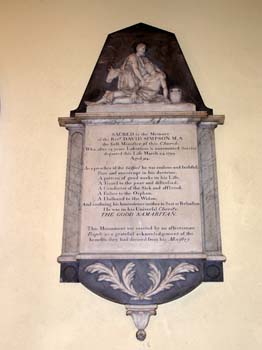 |
|
| View from the balcony | Monument to David Simpson |
Since 1985, Christ Church has been in the care of the Churches Conservation Trust. It remains consecrated and is used occasionally for services. Christ Church dates from 1775 when the town was growing rapidly as a result of the textile trade. There was at that time only one church and a Dissenting Chapel. The burial ground at St. Michael's was overcrowded and there were 500 burials a year. At the same time there was a growing interest in evangelism and Nonconformity. Charles Roe donated land for a new burial ground with a chapel and provided the funds. Roe was a local businessman who had built the first spinning mill in the town in 1743 and a larger mill in 1748. He used local coal to smelting and working copper and brass then moved on to develop successful copper mining at Paris Mountain in Anglesey. The East Window is dedicated to his son, daughter-in-law and grandson. He was mayor of Macclesfield in 1742 and from 1753 until his death in 1781, he lived at what is now known as Charles Roe House on the corner of modern Churchill Way and Chestergate.
A remarkable sequence of events ensued resulting in a change in Roe's plans. With Roe's support, David Simpson had been appointed Assistant Curate at St. Michael's in 1772. The Prime Curate, who was responsible for the burial ground, died in February 1773 and there was every expectation that Simpson would be promoted to succeed him. However, the Bishop of Chester appointed his own candidate, upsetting many in the congregation. A difficult situation arose between Simpson and the vicar, the Rev. Hughson. Simpson, an outspoken man with evangelical views, was pulled from the pulpit by Hughson while preaching. It must have been the talk of the town. For a time, Simpson had a small chapel in Hazel Grove where Chapel Street now stands. He built it at his own expense and remained outside the parish system for about three years.
Charles Roe changed his plans from a burial ground with a small chapel to a large auditory style church. The church, costing about £8,000, was built between Easter and Christmas of 1775 and it was consecrated in 1779. It had 600 free pews and 1000 rented ones. Simpson became the first minister. He had difficulty in disposing of his chapel at Hazel Grove but in 1786 sold it to the Wesleyans and it was opened by John Wesley, on his 83rd birthday, 5 April 1786. Christ Church did not have its own parish and was supported by pew rents and burial fees.
Simpson was influential in the founding of the Sunday School Movement, active in teaching, and in providing welfare services for his congregation. He was a friend of Wesley, who preached here on at least a dozen occasions including at Easter in 1777. He did not return until 1782, the year after Charles Roe's death.. Christ Church was the only Anglican church in the county to invite Wesley. It is known from Wesley's diary that on Good Friday of 1782 there was a congregation of 1,300. Simpson wrote many tracts and sermons. He establishing a society for women, dispensing free medicines and arguing for smallpox inoculation. Simpson was a fiery preacher and often filled the church. He was noted for holding up a large bible while he preached. However, his otherwise radical views did not extend as far as democracy; he preached against the French Revolution and against Thomas Paine, the author of "The Rights of Man", as did most Anglican clergy.
He remained the minister until he died in 1799 at the age of 54. Macclesfield at the time had an outbreak of a fever and Simpson contracted it from a parishioner. His wife died ten days before him. Simpson's memorial is shown in the photograph.
The columns supporting the gallery are of cast iron and were clad in wood in the 19th century. The tower used to have eight pinnacles. The three decker pulpit and choir stalls have been dismantled and put into storage. The font is of marble obtained from Castleton in Derbyshire. The Roe monument, shown in the photograph, gives details of his major achievements. It depicts the church, his silk mill at Park Green and his copper works in Liverpool.
The church was used until 1981. When it was built, it had no parish so there were no glebe lands or tithes. The income came from renting pews and from burial fees. Christ Church sold burial plots to members of the St. Michael's congregation. Christ Church continued to have rented pews until 1961.
Christ Church is not easy to photograph as it is the north side that offers the best view. Two of the photographs shown were taken at about 7 pm on 20 June when the sun illuminates the west end. The clock had stopped! Early morning light was still on the North face at 8 am on 3 July 2015.
The full text on the monument to Charles Roe is shown below with a small amount of editing in the archaic punctuation.
Whoever thou art
Whom a Curiosity to search into the Monuments of the Dead
Or an Ambition to emulate their living Virtues
Has brought hither:
Receive the Gratification of either Object in the Example of
CHARLES ROE Esqr
A Gentleman who with a slender Portion of his Entrance into Business carried on the Button and Twist Manufacture in this town with the most active Industry, Ingenuity and Integrity: and by a happy Versatility of Genius at different Periods of his Life first established here and made instrumental to the Acquisition of an ample Fortune, THE SILK AND COPPER MANUFACTORIES by which many thousands of families have been since supported. The Obstacles which Envy and Malevolence threw in his Way retarded not his Progress: enterprising, emulous and indefatigable, Difficulties to others were Incitements to Action to him. His mind was vast and comprehensive, formed for great Undertakings and equal to their Accomplishment. By an intuitive Kind of Knowledge he acquired an intimate Acquaintance with the Mineral Strata of the Earth: and was esteemed by competent judges greatly to excel in the ART OF MINING. In that Line his Concerns were extensive: and the Land Owners as well as Proprietors of the valuable Mine in the Isle of Anglesea are indebted to him for the Discovery.
It pleased the ALMIGHTY to bless his various Labours and benevolent Designs. - His grateful Heart delighted to acknowledge the Mercies he received - GOD was in all his Thoughts. - And actuated by the purest Sentiments of genuine Devotion which burnt steadily through his life and brighter as he approached the FOUNTAIN OF LIGHT, He dedicated to the Service of his MAKER a Part of that Increase His Bounty had bestowed, erecting and endowing at his sole Expense the elegant Structure which encloses this Monument: And which is remarkable, is built from the Surface of the Ground and completely finished both Inside and Out in so short a Space of Time as seven Months.
Reader: When thou hast performed the Duties which brought thee hither, think on the FOUNDER OF THIS BEAUTIFUL EDIFICE, And aspire after the Virtues which enabled him to raise it.
He died the 3rd of May 1781 aged 67 Years: leaving a Widow and ten Children
Who have erected this Monument as a Tribute to
Conjugal and filial Affection, poignantly to lament
A MOST INDULGENT HUSBAND
A TENDER FATHER and
A GENERAL LOSS
The above Charles Roe, was sixth son of the Revd Thomas Roe M.A.
26 years vicar of Castleton, Derbyshire, within the chancel of which church
His remains are interred
Sources:
Christ Church, Macclesfield, a
booklet by Tim and Julie Brinton with historical research by Dorothy Bentley
Smith, published by the Churches Conservation Trust. It is available from
the church.
Some of the information on David Simpson and
his time at Hazel Grove is from Ian May's course at Wilmslow Guild on Cheshire
Churches, Autumn 2001.
Charles Roe of Macclesfield, 1715-1781, an 18th Century Industrialist,
by W.H. Chaloner, M.A. Ph.D., part I, in Transactions of the Lancashire and
Cheshire Antiquarian Society, Vol. 62 page 133.
Christ Church is open to the public May to September,
Monday, Tuesday and Friday from 9 am until 4 pm.
Macclesfield
Page 1: Town Centre
Macclesfield Page 2:
Town Centre
Macclesfield Page 3:
Halls
Macclesfield Page 4: The
Canal
Macclesfield Page 5: Christ Church
Macclesfield Page 6:
St. Michael's, the Exterior & Nave
Macclesfield Page 7:
St. Michael's the Savage Chapel
Macclesfield Page 8: Nonconformist
Chapels
Macclesfield
Page 9: Some Macclesfield Mills